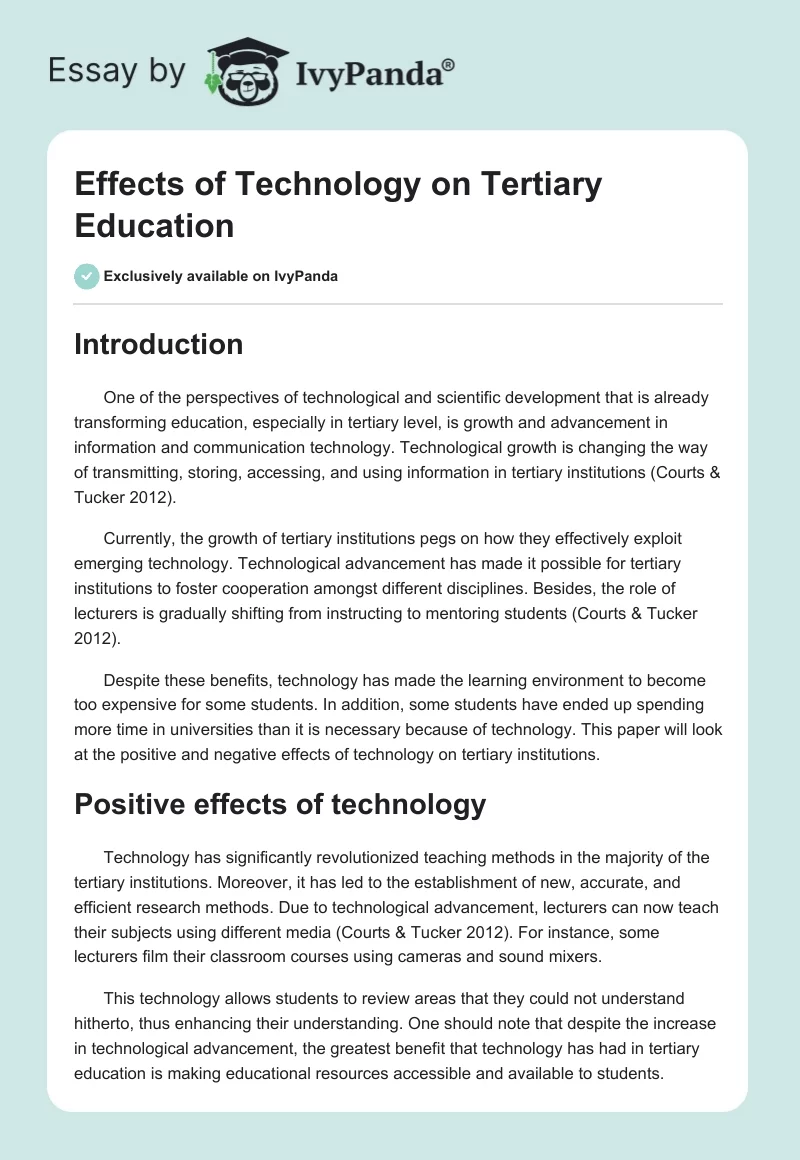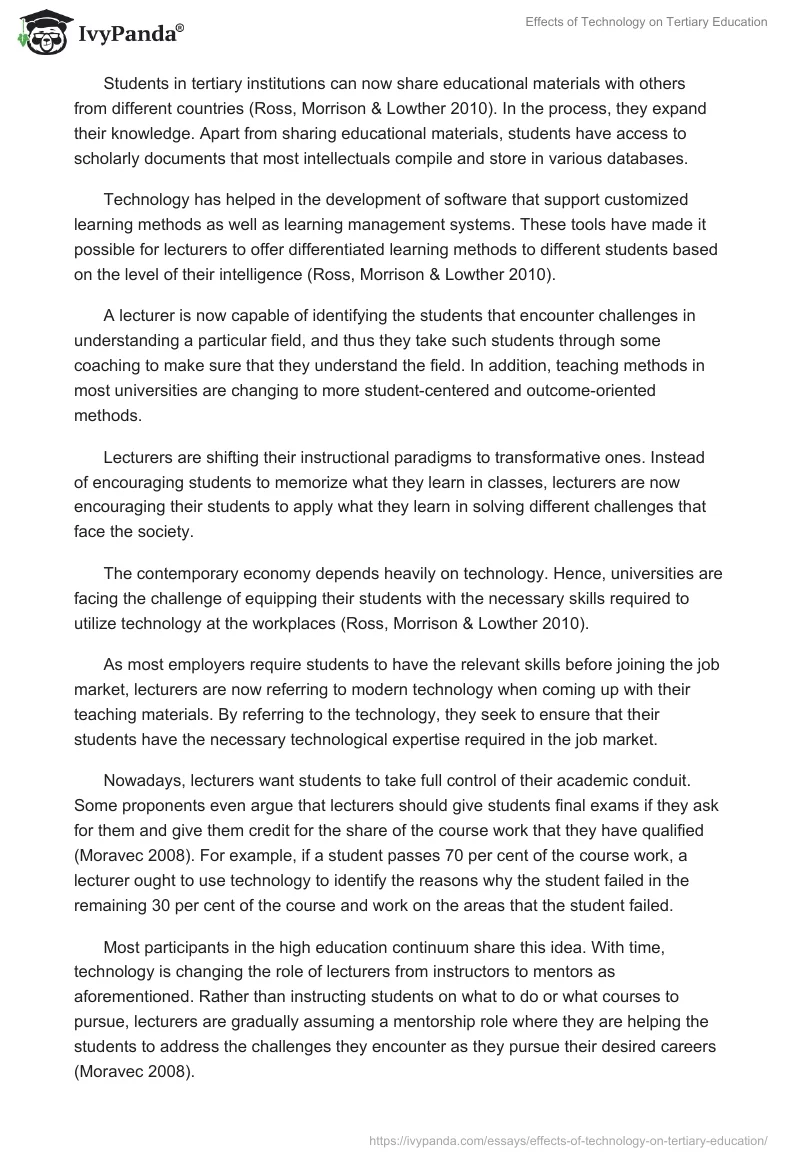Introduction
One of the perspectives of technological and scientific development that is already transforming education, especially in tertiary level, is growth and advancement in information and communication technology. Technological growth is changing the way of transmitting, storing, accessing, and using information in tertiary institutions (Courts & Tucker 2012).
Currently, the growth of tertiary institutions pegs on how they effectively exploit emerging technology. Technological advancement has made it possible for tertiary institutions to foster cooperation amongst different disciplines. Besides, the role of lecturers is gradually shifting from instructing to mentoring students (Courts & Tucker 2012).
Despite these benefits, technology has made the learning environment to become too expensive for some students. In addition, some students have ended up spending more time in universities than it is necessary because of technology. This paper will look at the positive and negative effects of technology on tertiary institutions.
Positive effects of technology
Technology has significantly revolutionized teaching methods in the majority of the tertiary institutions. Moreover, it has led to the establishment of new, accurate, and efficient research methods. Due to technological advancement, lecturers can now teach their subjects using different media (Courts & Tucker 2012). For instance, some lecturers film their classroom courses using cameras and sound mixers.
This technology allows students to review areas that they could not understand hitherto, thus enhancing their understanding. One should note that despite the increase in technological advancement, the greatest benefit that technology has had in tertiary education is making educational resources accessible and available to students.
Students in tertiary institutions can now share educational materials with others from different countries (Ross, Morrison & Lowther 2010). In the process, they expand their knowledge. Apart from sharing educational materials, students have access to scholarly documents that most intellectuals compile and store in various databases.
Technology has helped in the development of software that support customized learning methods as well as learning management systems. These tools have made it possible for lecturers to offer differentiated learning methods to different students based on the level of their intelligence (Ross, Morrison & Lowther 2010).
A lecturer is now capable of identifying the students that encounter challenges in understanding a particular field, and thus they take such students through some coaching to make sure that they understand the field. In addition, teaching methods in most universities are changing to more student-centered and outcome-oriented methods.
Lecturers are shifting their instructional paradigms to transformative ones. Instead of encouraging students to memorize what they learn in classes, lecturers are now encouraging their students to apply what they learn in solving different challenges that face the society.
The contemporary economy depends heavily on technology. Hence, universities are facing the challenge of equipping their students with the necessary skills required to utilize technology at the workplaces (Ross, Morrison & Lowther 2010).
As most employers require students to have the relevant skills before joining the job market, lecturers are now referring to modern technology when coming up with their teaching materials. By referring to the technology, they seek to ensure that their students have the necessary technological expertise required in the job market.
Nowadays, lecturers want students to take full control of their academic conduit. Some proponents even argue that lecturers should give students final exams if they ask for them and give them credit for the share of the course work that they have qualified (Moravec 2008). For example, if a student passes 70 per cent of the course work, a lecturer ought to use technology to identify the reasons why the student failed in the remaining 30 per cent of the course and work on the areas that the student failed.
Most participants in the high education continuum share this idea. With time, technology is changing the role of lecturers from instructors to mentors as aforementioned. Rather than instructing students on what to do or what courses to pursue, lecturers are gradually assuming a mentorship role where they are helping the students to address the challenges they encounter as they pursue their desired careers (Moravec 2008).
Technology is promoting innovative faculty researches, academic collaboration, and student engagement. Consequently, it is helping tertiary institutions do away with boundaries that existed amongst different academic disciplines (Crossley, Bray & Packer 2009). In the past, environmental engineering and chemical engineering were two very different disciplines.
However, technological advancement is bridging the gap between the two disciplines thus giving room for interdisciplinary majors. Technological advancement has made it possible for lecturers to come up with educational materials that draw clear correlations among different disciplines. In return, it has given room for students to pursue courses that integrate ideas from different disciplines.
Apart from the merge amongst different disciplines, technological advancement is making it possible for students from different universities to interact and share ideas. Numerous social media give students an opportunity to reach their friends in other institutions and share opinions regarding particular courses (Geer & Sweeney 2012).
There is a possibility that students will come up with customized degree programs in the next five years. Technology is helping students to access a wide range of educational materials. Besides, it is helping students to understand the materials by simplifying them. Hence, with time, students will be in a position to design their degrees either by gathering materials from their universities or from different universities and disciplines.
There has been an increase in interaction between tertiary institutions and private sector. For tertiary institutions to produce qualified students, they should have all the requisite technological equipments. However, most of these equipments are very expensive for the tertiary institutions (Geer & Sweeney 2012). In a bid to cope with this challenge, tertiary institutions are now collaborating with the private sector.
A majority of the smaller tertiary institutions are looking for corporate partners to help them to acquire the relevant technological equipments. This aspect stands out as the only alternative that such institutions can make sure that their students are equipped with the critical technological leadership.
Negative impacts of technology
Technology has had negative impacts on tertiary institutions. Since the introduction of technology in tertiary institutions, different institutions are gradually doing away with lecturers (Salmi 2004). Currently, students are relying on electronic media, televisions, and computers. Even though this development has helped to cut down on operational costs, the development does not motivate some students; on the contrary, it distracts them, thus making them opt to study from home.
Technology requires the incorporation of appropriate motivation for students to benefit from it (Salmi 2004). The majority of the institutions do not put this element into considerations. Hence, even though technology offers a wide range of educational materials, students end up not acquiring all the requisite skills since they are not motivated to do so.
Besides, at times, lecturers do not monitor their students to identify the areas they are pursuing, and this element allows some students to go overboard and studying areas that are of no relevance to their careers. This trend takes most of their learning time, which forces them to take more time than required to complete their courses.
Technology breakdown has also forced students to spend more time in tertiary institutions. There are courses that are taught through technological medium only. In case the medium breaks down, students are forced to wait until it is repaired for the studies to continue (Anderson, Groulx & Maninger 2011).
Therefore, the affected students end up spending more time in the institution, especially if the institution has to seek for assistance from external experts. In other instances, institutions end up producing incompetent personnel because lecturers hurried to complete the course within the set time, thus overlooking most of the critical skills.
Technology has pushed tertiary institutions into huge expenses. As one technology after another gets obsolete, institutions have to purchase the most advanced one to be at par with the technological advancement (Anderson, Groulx & Maninger 2011). Consequently, the learning environment has become expensive thus making it hard for many students to access tertiary education.
Conclusion
Technology has improved the learning environment of most tertiary institutions. Currently, students can pursue courses that bring together different disciplines. Besides, students can freely interact with others from different universities and share knowledge. With the current technological advancement in tertiary institutions, lecturers can address the weaknesses of individual students.
Moreover, students can review the areas they did not understand and consult their lecturers through electronic media. In spite of the numerous benefits of technology to tertiary institutions, the current challenge is to ensure that education is affordable to all students. In addition, tertiary institutions encounter the challenge of ensuring that technology does not alter the duration that a particular course is supposed to take.
Reference List
Anderson, S, Groulx, J & Maninger, R 2011, ‘Relationship among preservice teachers’ technology-related abilities, beliefs, and intentions to use technology in their future classroom’, Journal of Educational Computing Research, vol. 45 no. 3, pp. 215-253.
Courts, B & Tucker, J 2012, ‘Using Technology to Create a Dynamic Classroom Experience’, Journal of College Teaching & Learning (TLC), vol. 9 no. 2, pp. 121-128.
Crossley, M, Bray, M & Packer, S 2009, ‘Education in the small states of the commonwealth: towards and beyond global goals and targets’, The Round Table: The Commonwealth Journal of International Affairs, vol. 98 no. 405, pp. 731-751.
Geer, R & Sweeney, T 2012, ‘Students’ voices about learning with technology’, Journal of social sciences, vol. 8 no. 2, pp. 294-303.
Moravec, J 2008, ‘A new paradigm of knowledge production in higher education’, On the Horizon, vol. 16 no. 3, pp. 123-136.
Ross, S, Morrison, G & Lowther, D 2010, ‘Educational technology research past and present: balancing rigor and relevance to impact learning’, Contemporary Educational Technology, vol. 1 no. 1, pp. 134-156.
Salmi, J 2004, ‘Tertiary education in the 21st century: challenges and opportunities’, Higher Education Management, vol. 13 no. 2, pp. 105-129.


